How to Fix Error Code: BLZBNTAGT00000BB8 on Battle Net Launcher
Some Battle.net users are experiencing a weird issue with certain games where their attempt to download the base game or a new available update ends up with the BLZBNTAGT00000BB8 error code. Any attempts at re-initiating the download ends with the same error code. This problem is confirmed to occur on every recent Windows version including Windows 7, Windows 8.1, Windows 10, and Windows 11.

We’ve investigated this issue thoroughly and realized that there are actually several potential causes that might be responsible for this problem. Here’s a list of potential culprits that you should look for when experiencing this issue with the Battle.Net application:
- COD file integrity glitch – If you’re experiencing this issue solely with a Call of Duty title, you should be able to fix the problem by selectively deleting a series of small game dependencies in order to force the Battle.net launcher to figure out it’s time for an integrity check. This forced integrity check should reinstall the missing files and fix the error without the need to reinstall the entire game folder.
- The Battle.net login module is viewed as a security threat by 3rd party antivirus – You’d think that this is an isolated concern, but there are actually several different 3rd party AVs that are singled out for causing this problem due to a false positive. To fix this concern, you’ll either need to update to the latest virus signature or uninstall the problematic AV suite if the problem persists.
- Internet connection is not optimal – Another viable reason why you might be dealing with this issue is an instance where the Internet connection that you’re using is not optimal to accommodate game file downloads. Maybe you have programs running in the background that are hogging all the available Internet bandwidth or maybe you’re using an unreliable cellular, satellite, or WiMAX internet connection.
- Bad DNS Range – One other reason why you’re stuck with this error when attempting to install or update a game is a bad DNS range that ends up terminating the connection with the Battle.net server. If this scenario is applicable, you should be able to fix the problem by doing a DNS flush from an elevated Command Prompt.
- VPN or Proxy interference – Another viable culprit that might be actually causing the error in your case is a proxy server or a VPN service that is currently active on your PC. You can test this theory by temporarily disabling or uninstalling the Internet-surfing anonymity solutions that you’re currently using.
- Game Corruption – File corruption among the game files (or dependencies) can also be responsible for the BLZBNTAGT00000BB8 error (especially if you are also stuck in a scan & repair loop. In this case, the best course of action would be to reinstall the game conventionally.
- Game Launcher (Battle.Net) Corruption – The launcher itself might also be at fault for this error. This is very likely if you’re experiencing this error code with every new game you try to install or update. If this scenario is applicable, you should be able to fix the problem by uninstalling the Battle.net app and manually deleting the remnant files before reinstalling it again.
Now that we went over every potential cause that might ultimately prevent you from installing, updating, or launching a game through Battle.Net, let’s get to the actual fixes that other affected users have successfully used to resolve the BLZBNTAGT00000BB8 error code.
1. Delete everything except the data folder (COD titles ONLY)
If you’re experiencing this issue with a Call of Duty Modern Warfare title, the first thing you should do is deploy a fix that’s been circulating online. It involves selectively deleting a series of game files with the purpose of forcing Battle.Net to trigger an integrity check and re-download the missing files.
This method will save you from having to re-download the Call of Duty game – this is a big deal if you are using an ISP that limits the monthly bandwidth that is available to you.
The instructions below will guide you through the process of deleting a series of lightweight COD files in order to force the integrity check without prompting the game launcher to re-download the entire game.
Follow the instructions below for step-by-step instructions on enforcing this fix on PC:
Note: The instructions below should work on every recent Windows version.
- Open Battle.Net and select the Call of Duty game from your library menu.
- Next, click on the settings (gear-icon) associated with the launch button of the game and click on Show in Explorer from the context menu that just appeared.
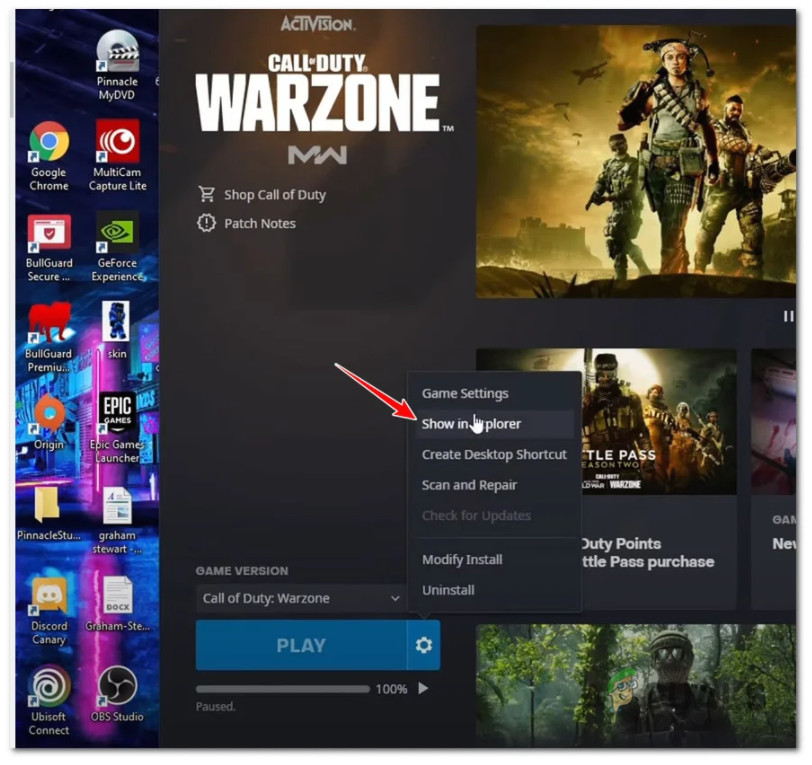
Access the game installation folder Note: This will beam you directly inside the installation folder of the COD title (regardless of whether you installed it in the default path or a custom one).
- Now, close the Battle.Net app and make sure it’s not running in the background by checking your taskbar menu.
- Inside the main location of the COD game installation, delete every other folder except data.

Delete every other folder except data - Once only the data folder remains, double-click on the data folder and use the search function at the top to search for ‘.idx’. Next, from the list of results, select & delete every .idx file.
- After you manage to delete every .idx file, go ahead and select every data folder that is of small size (a few kb) and delete them.
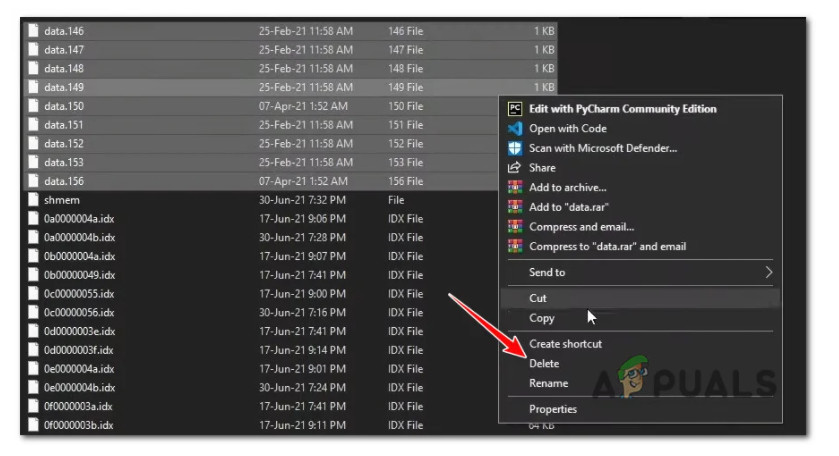
Delete the small data files Note: In order to make things easier for you, you can click on the Size column to order the data files according to their size. This will allow you to select the files that need to be deleted more easily.
- Once you did the cleanup chores and removed all the files specified above, you can launch Battle.Net once again and hit the Update / Install button after selecting the COD game.
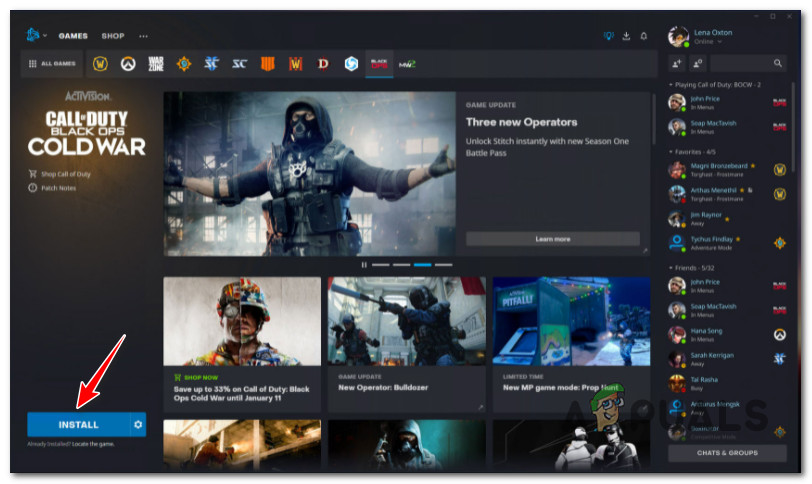
Forcing Battle.Net to trigger an integrity check Note: This action should force the game Battle.Net game launcher to recognize that some files are already installed and download just the files that are missing from the game installation.
If this method didn’t fix the issue in your case or you’re not experiencing the BLZBNTAGT00000BB8 error with a COD title, move down to the next potential fix below.
2. Update / Uninstall 3rd party security suite (if applicable)
As it turns out, this BLZBNTAGT00000BB8 error code can also be caused by a false positive triggered by your 3rd party antivirus suite.
Note: If you’re using Windows Security, skip this method and move directly to the next method below.
There are several different 3rd party suites that are most commonly singled out for causing this problem – Comodo Antivirus and Avast are the most common.
If you’re using a 3rd party antivirus and you suspect that it might be responsible for causing this problem, you should start by ensuring that you’re allowing your AV to use the latest available virus signatures.
In case you have conditioned the installation of newly available virus signatures, access your AV settings and install any pending AV update that is currently available.
Every AV interface is different, but you should be able to right-click on your AV suite icon inside the taskbar menu and choose Update / Update now. If this is not available, access the main interface and look for an option to install the latest available virus definitions.
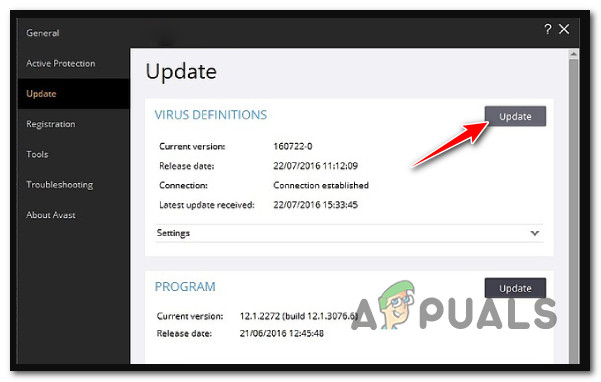
Once you’ve ensured that you installed the latest available virus signatures, reboot your PC and see if the Battle.Net BLZBNTAGT00000BB8 error is fixed once the next startup is complete.
If the same kind of issue persists, chances are the false positive is still not patched with the latest virus definition. In this case (if the 3rd party AV is to blame), the only viable solution is to simply uninstall the problematic tool to get rid of the interference.
Here’s what you need to do in this case:
- Press Windows key + R to open up a Run dialog box. Next, type ‘appwiz.cpl’ inside the text box and press Enter to open up the Programs and Features menu.
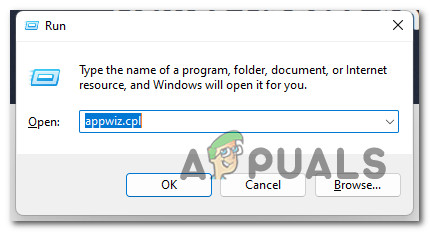
Open up the Programs and Features menu - If you’re prompted by the User Account Control (UAC) prompt, click Yes to grant admin access.
- Once you’re finally inside the Programs and Features menu, scroll down through the list of installed programs and locate the entry associated with the 3rd party AV that you suspect might be causing the problem.
- When you manage to locate the problematic suite, right-click on it and choose Uninstall from the context menu that just appeared.
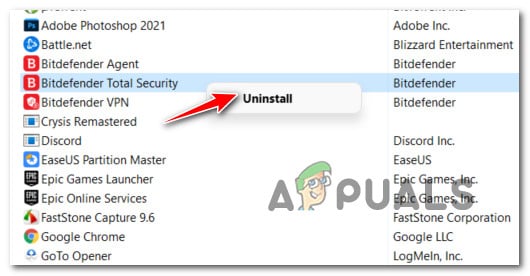
Uninstall the antivirus suite - Once you’re inside the uninstallation screen, follow the remaining prompts to complete the uninstallation, then restart your PC.
- After your PC boots back up, you should notice how the native AV (Windows Security) has taken over.
- Open Battle.Net once again and see if the BLZBNTAGT00000BB8 error is now fixed.
If the same kind of issue is still occurring, move down to the next potential fix below.
3. Ensure that your Internet connection is optimal
According to a few affected users, this problem is also sometimes associated with an unreliable wireless connection that is preventing the Battle.net launcher from downloading the required files.
If this scenario is applicable and you’re experiencing this issue, there are a few connection optimization steps that you can deploy to fix the problem:
- If possible, the most effective way to fix this connection problem is to plug your computer directly into your modem / router (instead of using a wireless connection)
- Turn down every other program that is eating away at your Internet bandwidth. Start by targeting download programs and P2P programs like uTorrent or BitTorrent if you use those.
- Avoid using cellular phones satellite or WiMAX internet connections since they are unstable and known to cause a lot of different connection issues with Battle.Net’s launcher.
Once you’ve applied these recommendations, attempt to install, update or launch the problematic game once again and see if the BLZBNTAGT00000BB8 error is now fixed.
If the problem is still not fixed, move down to the next potential fix below.
4. Deploy a DNS flush
If the network optimization steps featured in the method above didn’t allow you to fix the problem, that doesn’t mean the issue isn’t related to a network element.
It can be just as easily a problem facilitated by a bad DNS (Domain Name System) range that inhibits the connection between your local Battle.Net installation and the download server.
Several affected users that we’re dealing with the same kind of problem have reported that they finally managed to fix the issue by opening an elevated Command Prompt window and running a command that’s capable of clearing the DNS cache.
Note: This method was confirmed to be effective on both Windows 10 and Windows 11 computers that we’re dealing with the BLZBNTAGT00000BB8 error.
Here is some step by step instructions that will allow you to clear your current DNS cache:
- Press Windows key + R to open up a Run dialog box. Next, type ‘cmd’ inside the text box, then press Ctrl + Shift + Enter to open up an elevated Command Prompt window.
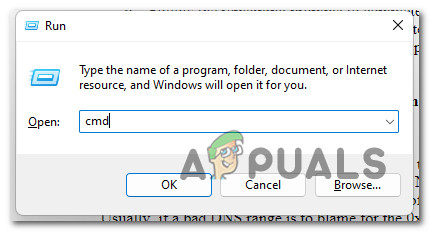
Open up an elevated command prompt - If you are prompted by the User Account Control (UAC) prompt, click Yes to grant admin access.
- Once you’re inside the elevated CMD prompt, type the following command and press Enter to perform a complete DNS flush:
ipconfig/flushdns
Note: This will essentially remove any information associated with the DNS cache – this will force the router to assign a brand new DNS range.
- After the command is processed successfully, close the elevated CMD prompt and restart Battle.Net before trying to install or update the game that was previously failing with the BLZBNTAGT00000BB8 error.
If the problem is still not resolved even after you flushed your DNS cache, move down to the next potential fix below.
5. Disable any potential interfering proxies / VPNs
Keep in mind that another reason why you might be seeing this type of problem is an instance where the login module on Battle.Net (the one that needs to validate every new download) is being inhibited by a proxy or VPN software.
If this scenario is applicable, you really don’t have any available fixes that will allow you to whitelist Battle.Net. The only thing you can do really is disabling the proxy or VPN interference.
This particular fix was confirmed by several users that we’re all dealing with this problem.
Of course, the procedure of doing so will be different depending on if you’re using a proxy or a VPN (natively or via a standalone program).
There are actually 3 scenarios that we’ve covered below:
- You’re connected to a proxy server (Follow sub guide 5.1)
- You’re connected to a VPN natively (Follow sub guide 5.2)
- You’re connected to a VPN via a standalone 3rd party program (Follow sub guide 5.3)
Depending on the scenario that is applicable in your case, follow one of the three sub-guides featured below:
Disable a Proxy server
If you’re using a proxy server, all yu need to do is access the Proxy tab of the Settings menu and ensure that the use of a proxy server on this Windows installation is disabled.
Note: The instructions below should work for both Windows 10 and Windows 11 computers.
Here’s what you need to do:
- Press Windows key + R to open up a Run dialog box. Next, type “ms-settings:network-proxy” inside the text box and press Enter to open up the Proxy tab of the Settings app.
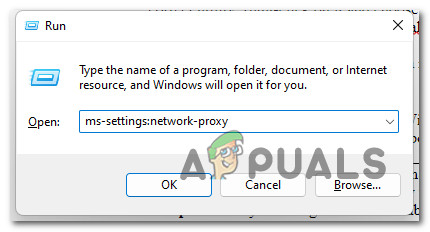
Access the Proxy settings menu Note: If you’re prompted by the User Account Control (UAC), click Yes to grant admin access.
- Once you’re inside the Proxy tab, move over to the right-hand section of the screen, and disable the Automatic proxy setup or the Manual Proxy Setup (depending on which one you have set up).
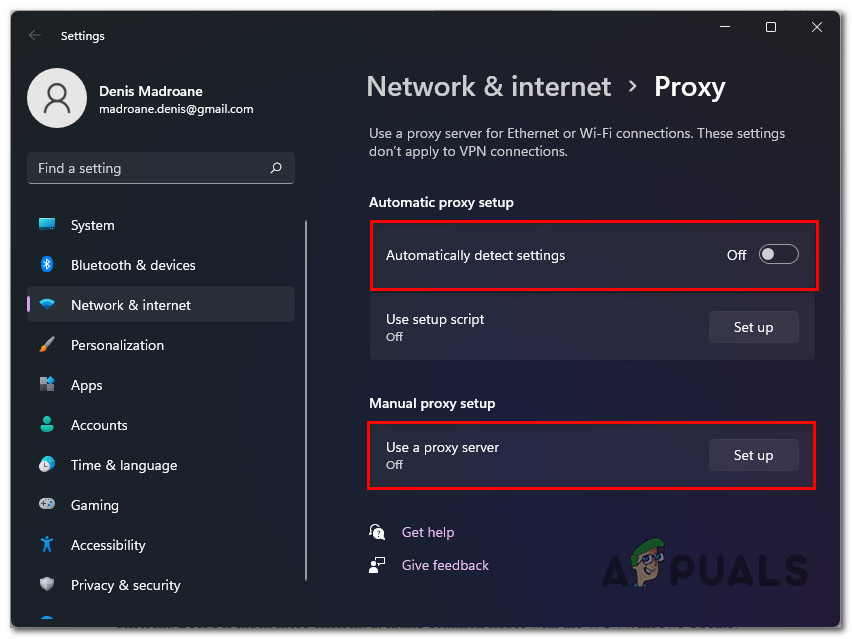
Disable the Proxy server - Once the proxy server is disabled, close the Settings menu, then reboot your PC and see if the BLZBNTAGT00000BB8 error is now fixed.
If the problem is still not fixed, move down to Method 6 below.
Disable a native VPN connection
If you’re using a VPN connection that is configured natively (via the VPN connection tab), you will need to disable the VPN connection by accessing the Network & internet connection menu.
Note: If you’re using a standalone VPN app, follow the sub guide below (5.3) for the correct steps on disabling the VPN interference.
Here’s what you need to do to disable a native VPN connection:
- Press Windows key + R to open up a Run dialog box. Next, type ‘ms-settings:network-vpn’ and hit Enter to open the VPN tab of the Settings menu.

Accessing the VPN tab of the settings menu Note: This command will work on both Windows 10 and Windows 11.
- Once you’re inside the VPN tab, move over to the right-hand section of the screen and click on the VPN connection (under VPN connections).

Remove the VPN connection - At the confirmation prompt, click on Confirm to finalize the operation of the VPN removal.
- Reboot your PC and see if the problem is now fixed by launching Battle.Net again.
If you’re still experiencing the BLZBNTAGT00000BB8 error when attempting to install or update a Blizzard or Activision game, move down to the next potential fix below.
Uninstall the 3rd party VPN app
If you’re using a standalone VPN app, you will need to get rid of it by using the Programs and Features menu.
Note: Keep in mind that just disabling it won’t do the job since the same kind of interference will likely linger around passively.
Follow the instructions below to uninstall the standalone VPN app that you’re currently using:
- Press Windows key + R to open up a Run dialog box. Next, type ‘appwiz.cpl’ and press Ctrl + Shift + Enter to open the Programs and Features menu with admin access.
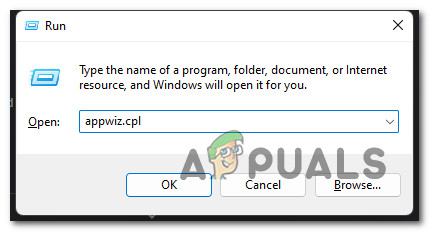
Open up the Programs and Features menu - If you’re prompted by the User Account Control, click Yes to grant admin access.
- Inside the Programs and Features menu, scroll down through the list of installed programs and locate the VPN program that is causing this issue.
- Once you manage to locate it, right-click on it and choose Uninstall from the context menu.
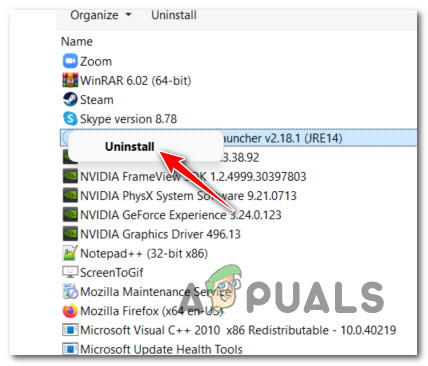
Uninstall the VPN suite - Click Yes at the confirmation prompt, then follow the remaining prompts to complete the uninstallation of the VPN tool.
- Reboot your PC and see if the BLZBNTAGT00000BB8 error is now resolved.
If you still end up seeing this error code when attempting to install or update a game via Battle.Net, move down to the next potential fix below.
6. Reinstall the problematic game
If you’ve come this far without a viable fix, the next thing you should do is troubleshoot against a potential issue having to do with game data corruption.
A good start would be to attempt to uninstall the game via Battle.Net’s interface before trying to clean install it again. To do this directly from the interface of Battle.Net, select the game that’s triggering the BLZBNTAGT00000BB8 error and then click on the gear icon (near the blue Update or Install button).
From the context menu that just appeared, click on Uninstall.

Follow the remaining prompts to complete the uninstallation, then reboot your PC.
After your PC boots back up, open the Battle.Net once again and install the game once again.
There will be situations where you won’t be able to uninstall the game conventionally (directly using Battle.Net). In this case, follow the instructions below to uninstall the game manually and clear any remnant files that might be interfering with the next installation attempt:
- Press Windows key + R to open up a Run dialog box. Next, type ‘appwiz.cpl’ and press Ctrl + Shift + Enter to open up the Programs and Features menu with admin access.
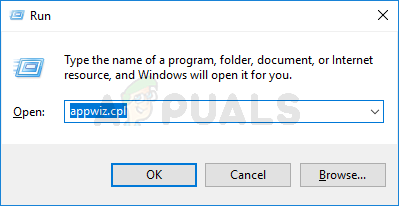
Open up the Programs and Features menu - Once you’re inside the Programs and Features menu, scroll down through the list of installed programs and locate the entry associated with the game that you wish to uninstall.
- Next, right-click on the problematic game and choose Uninstall from the context menu that just appeared.

Uninstall the game - Inside the uninstallation screen, follow the remaining steps to complete the uninstallation process.
- Reboot your PC, then return to Battle.Net and force the reinstallation of the game.
If the problem is still not fixed, move down to the next potential fix below.
7. Reinstall Battle.net after clearing remnant files
If the method above was not effective in your case, one final culprit that is most likely responsible is some type of corruption that is affecting the current installation of Battle.Net.
Chances are the problem is not caused by a direct application file that’s affected by corruption, rather by a temporary file that is currently located in one of the various cache folders that Battle.Net uses.
Several affected users have confirmed that they finally managed to fix the issue after reinstalling Battle.net after clearing out any remnant files that are likely responsible for the problem.
Follow the instructions below to reinstall Battle.Net after clearing the remnant files:
- Press Windows key + R to open up a Run dialog box. Next, type ‘%LOCALAPPDATA%’ inside the text box and press Enter to open the hidden Local App data folder.
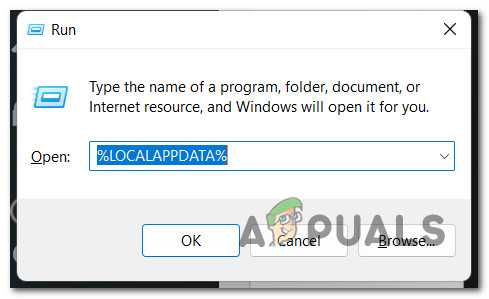
Accessing the Local App Data folder - Once you’re inside, delete the Battle.net, Blizzard, and/or Blizzard Entertainment folders.
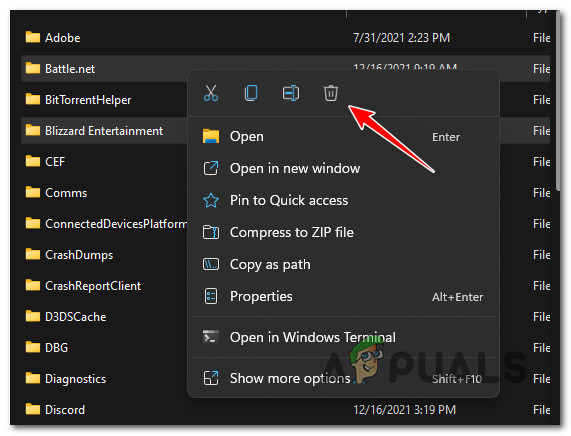
Delete the Battle.Net related folders - Next, open another Run box (Windows key + R) and repeat the step above with %APPDATA%, %TEMP%, and %PROGRAMDATA%.
Note: Just like before, delete any Battle.net, Blizzard, and/or Blizzard Entertainment folders that you end up finding inside these folders. - Finally, reboot your PC and install the latest version of Battle.net from the official website after the next startup is complete.

Downloading the latest version of Battle.Net - Attempt to install the game that was previously causing the blzbntagt00000bb8 and see if the problem is now fixed.





